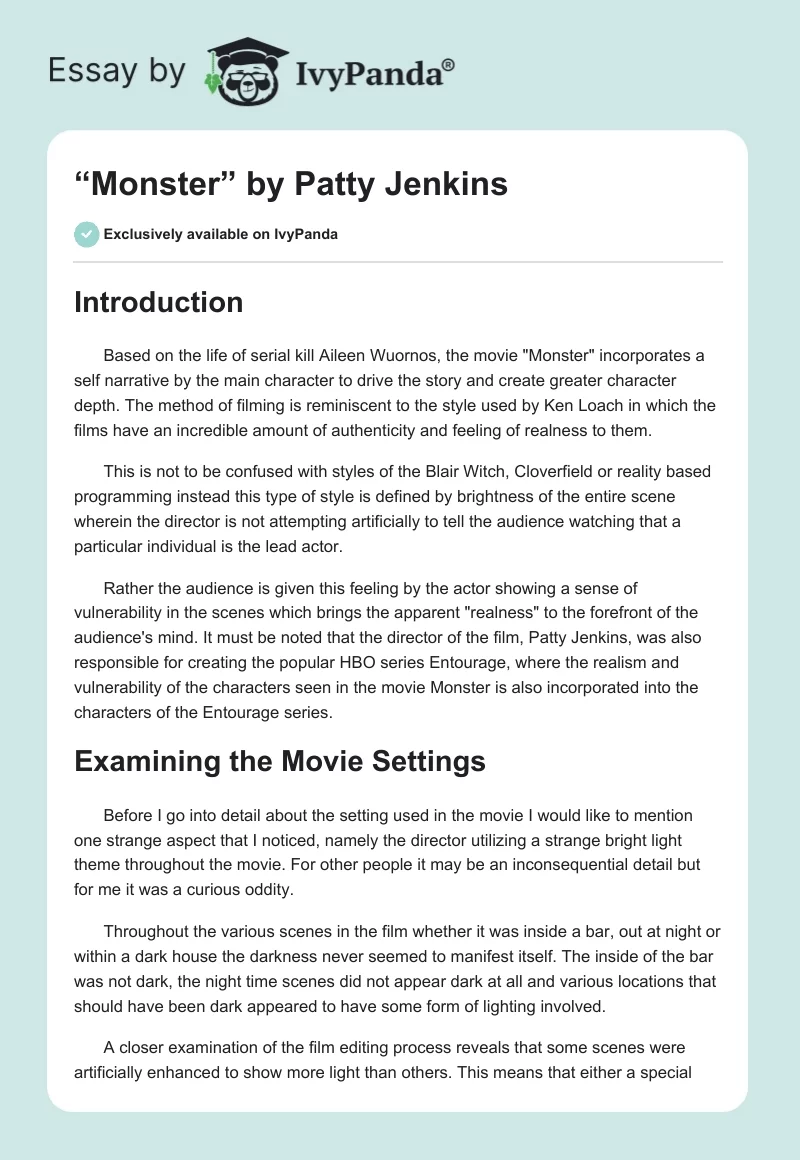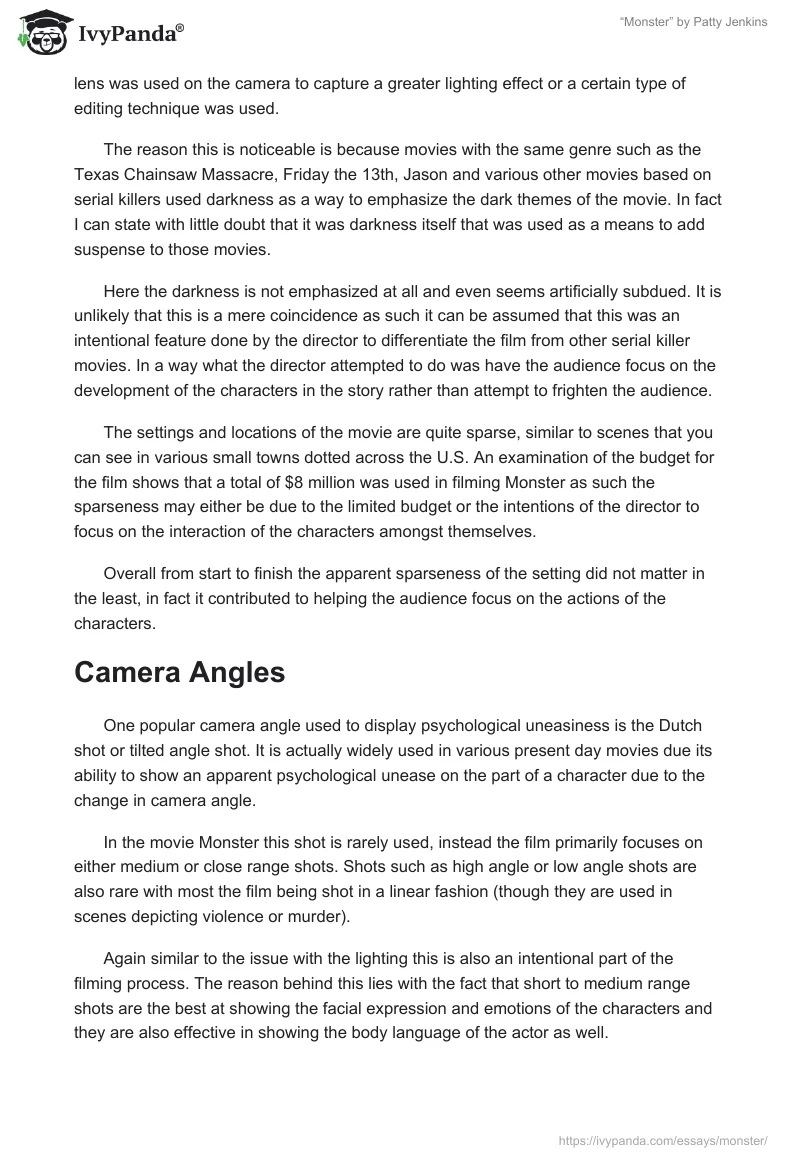Introduction
Based on the life of serial kill Aileen Wuornos, the movie “Monster” incorporates a self narrative by the main character to drive the story and create greater character depth. The method of filming is reminiscent to the style used by Ken Loach in which the films have an incredible amount of authenticity and feeling of realness to them.
This is not to be confused with styles of the Blair Witch, Cloverfield or reality based programming instead this type of style is defined by brightness of the entire scene wherein the director is not attempting artificially to tell the audience watching that a particular individual is the lead actor.
Rather the audience is given this feeling by the actor showing a sense of vulnerability in the scenes which brings the apparent “realness” to the forefront of the audience’s mind. It must be noted that the director of the film, Patty Jenkins, was also responsible for creating the popular HBO series Entourage, where the realism and vulnerability of the characters seen in the movie Monster is also incorporated into the characters of the Entourage series.
Examining the Movie Settings
Before I go into detail about the setting used in the movie I would like to mention one strange aspect that I noticed, namely the director utilizing a strange bright light theme throughout the movie. For other people it may be an inconsequential detail but for me it was a curious oddity.
Throughout the various scenes in the film whether it was inside a bar, out at night or within a dark house the darkness never seemed to manifest itself. The inside of the bar was not dark, the night time scenes did not appear dark at all and various locations that should have been dark appeared to have some form of lighting involved.
A closer examination of the film editing process reveals that some scenes were artificially enhanced to show more light than others. This means that either a special lens was used on the camera to capture a greater lighting effect or a certain type of editing technique was used.
The reason this is noticeable is because movies with the same genre such as the Texas Chainsaw Massacre, Friday the 13th, Jason and various other movies based on serial killers used darkness as a way to emphasize the dark themes of the movie. In fact I can state with little doubt that it was darkness itself that was used as a means to add suspense to those movies.
Here the darkness is not emphasized at all and even seems artificially subdued. It is unlikely that this is a mere coincidence as such it can be assumed that this was an intentional feature done by the director to differentiate the film from other serial killer movies. In a way what the director attempted to do was have the audience focus on the development of the characters in the story rather than attempt to frighten the audience.
The settings and locations of the movie are quite sparse, similar to scenes that you can see in various small towns dotted across the U.S. An examination of the budget for the film shows that a total of $8 million was used in filming Monster as such the sparseness may either be due to the limited budget or the intentions of the director to focus on the interaction of the characters amongst themselves.
Overall from start to finish the apparent sparseness of the setting did not matter in the least, in fact it contributed to helping the audience focus on the actions of the characters.
Camera Angles
One popular camera angle used to display psychological uneasiness is the Dutch shot or tilted angle shot. It is actually widely used in various present day movies due its ability to show an apparent psychological unease on the part of a character due to the change in camera angle.
In the movie Monster this shot is rarely used, instead the film primarily focuses on either medium or close range shots. Shots such as high angle or low angle shots are also rare with most the film being shot in a linear fashion (though they are used in scenes depicting violence or murder).
Again similar to the issue with the lighting this is also an intentional part of the filming process. The reason behind this lies with the fact that short to medium range shots are the best at showing the facial expression and emotions of the characters and they are also effective in showing the body language of the actor as well.
It must be noted that the purpose of the director in the movie is to have the main character lead the scene rather than the scene leading the main actor. For those of you not familiar with this phrase, movies such as The Matrix series, Star Wars and the classic movie Jumanji are all examples of movies where the scenes move the character.
In such movies actions revolve around an external factor being introduced into the scene whereupon the main character has to act on it. In movies such as Monster, Erin Brokovich and Castaway the scenes are led by the actions of the characters within it rather than an external force such as a sentinel attack in the Matrix, a sudden invasion by the Empire as seen in Star Wars or a sudden stampede coming through a wall in Jumanji.
Another interesting aspect to take note of is that the camera itself blurs extras in the backgrounds even during long range shots while intently focusing on the main characters in the film. While this is a widely used technique it must be noted that such a technique is usually used when the intent of the director is to focus on character development.
Color grading of the Film
Directors these days tend to color grade their film to suit certain styles, for example the Matrix has a distinctly greenish color grading which conforms to theme of the green lighted text that represents digital code in the movie. Ocean’s 12 used a distinctly orange color grading scheme while the movie 300 used a faded reddish orange color grading scheme.
While certain color schemes do add a certain unique quality to films they tend to distract audiences away from the actions of the main characters and focus more on the background visuals. This is evident in the Matrix and 300 where the stunning backgrounds used in the films are enhanced by the color scheme used to have audiences focus on the backgrounds.
Unfortunately such a technique has been used so many times that it has lost much of each appeal. In the movie Monster instead of colors being enhanced they are actually subdued. For example every time the main character looks at the mirror the subdued colors of her hair strands and skin are immediately apparent. While most people might think that this could just be the work of effective hair dyes an examination of the rest of the film shows that all the scenes have a subdued color scheme.
In other words instead of an enhanced color scheme the director went in another direction and chose to subdue the colors instead. The reason behind this is once again connected to the theme of character development. The subdued colors and apparently sparse backdrops further showcase the actions of the main character with the audience focusing on the actions of Charlize Theron rather than what is going on in the background.
Lack of Animation and Visual Effects
Despite being made in 2003 the movie lacks any animation or visual effect, on the other hand it could can be stated the movie itself just does not require them. Movies that focus on character development rarely have a visual effect and as such this movie is a clear cut example of a film that just does not require them despite the popularity of visual effects at the time.


